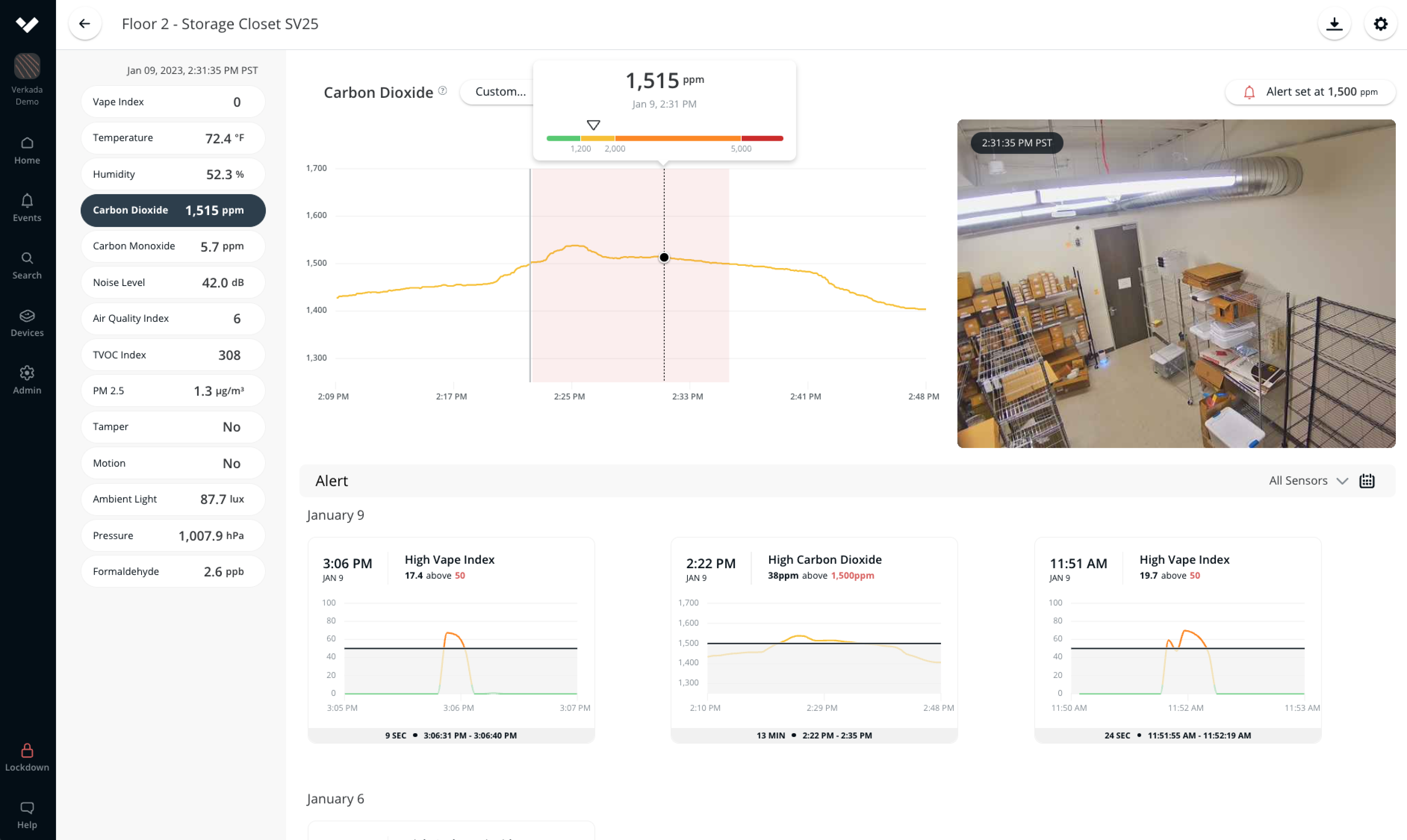By design, environmental sensors are monitoring tools that shed a light on invisible threats that would otherwise go undetected.
Yet, capabilities do vary from solution to solution. Barriers to deployment, such as limited integrations or decentralized device management, can prove time-consuming and costly. Limited functionalities, such as range or remote access, can affect both the overall effectiveness and usability of a system.
To address these challenges, Verkada’s Environmental Sensors were designed with key features that enable ease of remote management, reliable threat detection, and faster incident resolution.
In this blog, we share many of the differentiating features of Verkada’s cloud-based sensor solution and the benefits these built-in capabilities provide to organizations.
Real-Time Proactive Alerts
With Verkada Environmental Sensors, organizations have the ability to create granular, customized thresholds and alerts for notifying users of critical changes occurring within their environment. Through Verkada’s Command software platform, alerts can be set to trigger when noise level, TVOC, particulate matter, air quality, motion, temperature, or humidity fall out of range. This allows organizations to catch incidents right as they happen to mitigate damage. If smoking is detected in a school bathroom or if temperature falls out of range in a server room, staff will be alerted immediately via SMS or email.

Custom Dashboards for Sensor Readings
As a multi-sensor solution, Verkada sensors are capable of providing a wide range of sensor readings for monitoring changes occurring across an organization’s environment. From Command, organizations can enable specific sensors that are relevant to the area they’re monitoring. Doing so allows teams to quickly view information that is important to what they need to monitor, filtering out anything else that could be distracting.

For example, a school may have various sensors deployed to monitor different areas and their relevant scenarios. In a bathroom, administrators may want to only monitor for incidents that may indicate smoking or bullying. In that case, they would only need to enable and monitor that sensor’s Vape Index and Noise Levels. However, for the sensor in the IDF closet, it is critical to monitor Temperature and PM 2.5 to detect changes that may impact equipment performance and health.
Integration with Verkada Cameras
By viewing sensor data alongside video footage, organizations can gain additional context into environmental changes and events. Verkada’s natively integrated platform allows for video and sensor data to sync automatically to remote, web-enabled dashboards for easier investigations and live monitoring. This provides visual context when sensor readings fall out of range. Video footage can be viewed alongside alerts to validate the cause of anomalies; spikes in TVOC could indicate a chemical leak, or just regular cleaning.

Trend Detection
Through Command, users are able to view a high-level trendline of sensor readings over a 30-day period. This provides a baseline for what is normal, so it’s immediately apparent when issues arise. In the clip below, Carolina Ingredients investigates the cause of a sudden increase in particulate matter (PM 2.5) in the breakroom. Within seconds, they were able to deduce that the spike was caused by an open door by viewing the corresponding video footage.
Additionally, all event data is automatically retained for up to 365 days so users can pull historical data prior to 30 days as needed. By automating the task of logging and collecting data, organizations have a record of being in compliance, reduce the time required for audits, and ensure higher levels of accuracy and record completeness.
Remote Web-based and Mobile Access
With Verkada sensors, organizations have the ability to remotely monitor critical areas from anywhere in the world. Sensor-based events can be accessed through any web-based or mobile browser via Command, where information from all devices is combined—including video and access control. All physical safety events live on one centralized dashboard, making it easy to view and mitigate visible—and invisible—threats as they happen. This enables organizations to respond quickly to real-time alerts, as even the slightest delay in incident response can have far-reaching consequences on the people and assets within facilities.
Watch Verkada Sensors in Action
An effective and efficient system is one that brings the most long-term value to your organization by evolving with its needs over time, as well as integrating seamlessly within your security network. To see how these key features are used in a real-world environment, join our next webinar or request a live demo.



